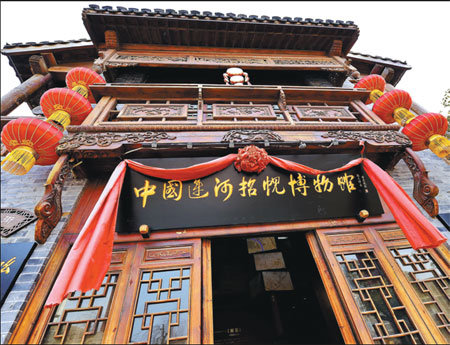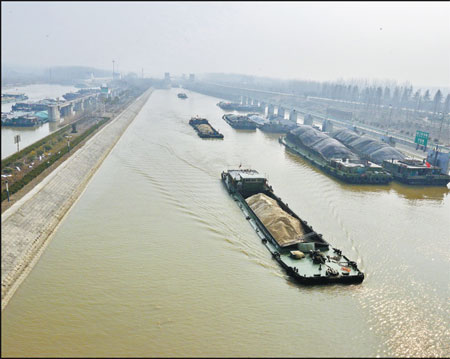Waterway withstands the tides of change to bring new hope
Updated: 2014-04-03 08:21
By Zhao Ruixue in Zaozhuang,Shandong (China Daily)
|
|||||||||||
Zhao Xiumei turned to wickerwork in 2001 after being laid off from her mining job in Shandong province's Zaozhuang, where the economy slumped after its coal reserves dwindled.
But she barely earned enough to make ends meet.
"Zaozhuang was known for its coal. We had no tourists. My wickerwork could only be sold to dealers, so I earned little from production," the 41-year-old says.
But things have changed for the better - the city's tourism industry boomed as the ancient Grand Canal has become an increasingly popular travel destination.
Her fortunes reversed when she rented a 20-square-meter space in the rebuilt ancient town of Tai'erzhuang on the bank of the Jia Canal, a stretch of the interprovincial waterway.
"I never imagined my business would grow so fast," she recalls.
"Tourists like to buy wickerwork souvenirs. I earn up to four times what I did before."
Zhao now runs a 102-square-meter store in Tai'erzhuang, selling eight kinds of wicker items, including boxes, baskets and furniture.
She also heads up a cooperative of about 200 women, who make wicker products for her.
"It's the ancient town that has helped me expand," Zhao says. "The canal has run through the town for centuries. It will continue to bless our business. I have faith in it."
The 2-square-kilometer town is home to nearly 20,000 people.
Tai'erzhuang was rebuilt after the ancient town was destroyed during the War of Resistance against Japanese Aggression (1937-45).
It was established in the Han Dynasty (206 BC-AD 220) and thrived during the Ming Dynasty (1368-1644) when the Jia Canal was built through the town.
"Tai'erzhuang became prosperous overnight because of the Grand Canal," Zaozhuang's Party chief Chen Wei says.
The Jia Canal is colloquially known as the "canal of pound locks" because eight locks control water levels.
Tai'erzhuang had the first pound lock barges pass through when the water enters Shandong from Jiangsu province.
"In ancient times, passing through a lock took at least two weeks and sometimes up to two months. So merchants had to stay in Tai'erzhuang, which boosted the town's economy," Zaozhuang's Grand Canal culture promotion office expert Dong Yunqi says.
The Annals of Yi County records that more than 10,000 barges passed through Tai'erzhuang a year, making the town an important transport base during the Ming and Qing (1644-1911) dynasties.
Tai'erzhuang's permanent population then reached 60,000, and about 150,000 others passed through every year, Dong says.
These people left great legacies - both tangible and intangible.
The town once had about 6,000 buildings constructed in eight architectural styles and 72 temples for major world religions, such as Catholicism, Islam, Protestantism and Buddhism, Dong says.
But the ancient town of Tai'erzhuang was mostly destroyed during World War II. The local government began rebuilding in 2006 to lure tourists. It has worked to make the new Tai'erzhuang as close to the old one as possible.
"Tai'erzhuang enjoys great fortune bestowed by the Grand Canal," Chen says.
The rebuilt town is a 5-A site - the top national tourism designation.
About 2.6 million tourists visited Tai'erzhuang per year, making it Shandong's third most popular attraction, after Confucius' hometown Qufu and Tai'an city's Mount Taishan.
"Zaozhuang had no tour buses or local tour guides before it was rebuilt," deputy director of the city's tourism office Du Jianmin says.
"It now has more than 100 tour buses and 400 local tour guides."
The city previously had 4,700 hotel beds with a less than 40 percent occupancy rate but now has at least 50,000 hotel beds.
"And four five-star hotels are now under construction, but it will still be insufficient to meet demand in peak seasons," Du says.
Yu Fuxin, a 52-year-old writer born in Taiwan, has decided to spend the rest of her life at Tai'erzhuang, where her family originated.
But she was less than impressed when she first visited decades ago.
"The coal-producing city was dull and dilapidated," she recalls. "I wouldn't have visited if my grandmother didn't live here."
But now she's glad to call Tai'erzhuang home, she says, standing on the Grand Canal's Yu Family Dock.
"The canal brings prosperity and hope," she says.
The cultural resources that spring from the waterway will never dry up, Chen says. It transcends time and has enriched people for generations, he says.
"The canal's significance isn't its engineering but rather its legacies," Chen says. "This transcends all changes."
zhaoruixue@chinadaily.com.cn
|
A newly opened folk art museum becomes another tourist site in Tai'erzhuang. |
|
Barges pass the Zaozhuang section of the Grand Canal. |
(China Daily 04/03/2014 page18)
Today's Top News
Turkey expects China's high speed rail investment
Search for MH370 'must not ease up'
China announces economic package
2 more human H7N9 cases in China
Full text of China's policy paper on EU
Xi's trip builds bridge to Europe
China Daily wins award in UK
NATO halts co-op with Russia
Hot Topics
Lunar probe , China growth forecasts, Emission rules get tougher, China seen through 'colored lens', International board,
Editor's Picks

|

|

|

|

|

|







